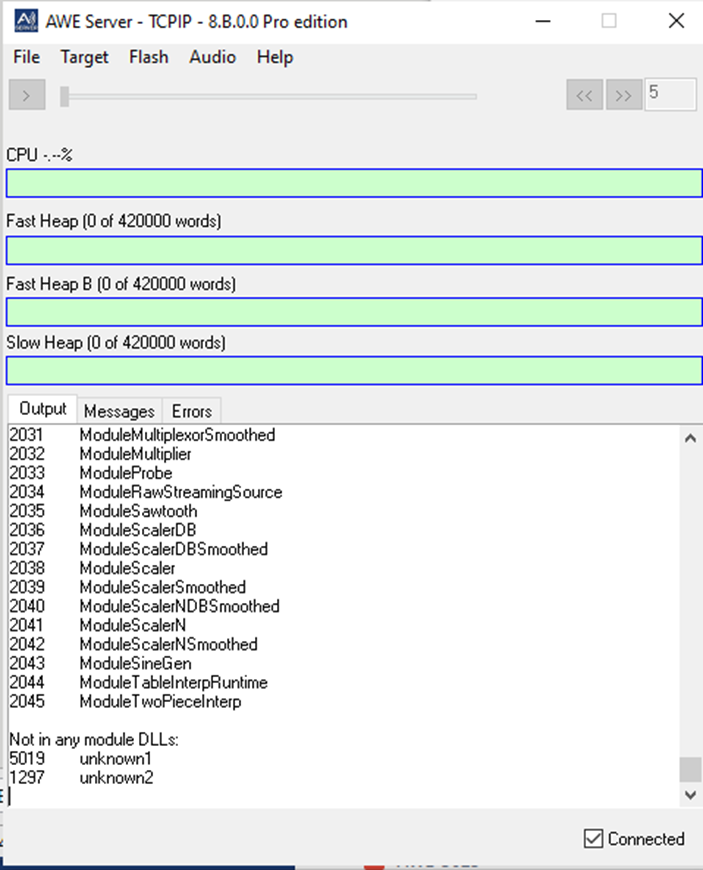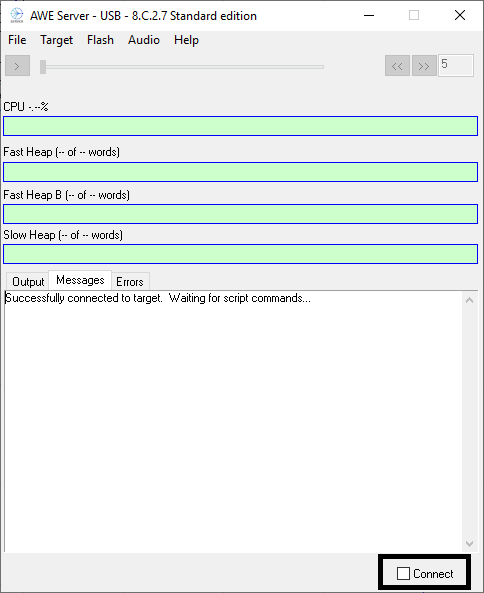AWE Server Menus
Target Info
The Target Info window in AWE Server shows information about the currently connected target. It is displayed by default in the AWE Server window, but to navigate back, use Target->Show Info.
When in Native mode, the Target Info will always be the same (per Designer release, where the version will change). When connected to an external target (BSP), it will show information about that specific target. Some of this info comes from the target’s AWE Instance structure itself (configured by BSP author), and the rest is built into the AWE Core library from DSPC (and therefore immutable by the BSP author). It is important to note that a BSP can have multiple AWE Instance's, but the Target Info display can only show info for one instance at a time. Use the dropdown selector to show the target info of each available AWE Instance on the connected target (see Multi-Instance section).
For more information about the AWE Instance and its configuration, see the AWE Core 8 API Quick Start.
Name: | Name of the AWE Instance, set by the BSP author at initialization time. Always Native if AWE Server is in Native mode.
|
AWECore Version | Version of the AWE Core (or AWE Core OS) library linked into the BSP, or in the Designer release (if Native mode) Built into the AWE Core library, immutable. |
Processor type | Represents the actual CPU type (example CortexA, etc). Will be Native for any Windows based target. Built into the AWE Core library, immutable. |
CPU clock rate | Processing speed of the CPU that is running the AWE Instance. Used for profiling within Audio Weaver Designer. Set at AWE Instance initialization time by BSP author.
|
Profile clock rate | The rate at which profiling ticks will occur, works in conjunction with CPU clock rate when profiling in Audio Weaver Designer. Set at AWE Instance initialization time by BSP author.
|
Sample rate | The basic sampling rate of the AWE Instance. Set at AWE Instance initialization time by BSP author.
|
Basic block size | The fundamental block size of the AWE Instance, usually corresponds with the targets HW block size. (also frequently referred to as DMA blocksize) Set at AWE Instance initialization time by BSP author.
|
Communication buffer size | The size of the packet buffers in the AWE Instance’s tuning interface implementation. The recommended packet buffer size is 264 words for a BSP, but will always be 4105 when in Native Mode. Set at AWE Instance initialization time by BSP author.
|
Is FLASH supported | Does the connected BSP implement a flash file system? (Optional) Set at AWE Instance initialization time by BSP author. |
Size of 'int' | Size of an integer in bytes. Built into the AWE Core library, immutable. |
Heap padding | Does the AWE Core build include heap padding? Built into the AWE Core library, immutable. |
Core ID | The “Instance ID” of the currently selected AWEInstance. “Core” terminology is outdated, but remains from AWE6 legacy. Set at AWE Instance initialization time by BSP author. |
Static core | AWE6 Legacy, unused. |
Threads | How many threads are implemented/available on the BSP. Set at AWE Instance initialization time by BSP author.
|
Pins: Input: <number of input channels> <type> Output: <number of output channels> <type> | BSP Audio IO channel counts. Usually corresponds with IO audio channels available on target hardware. Set at AWE Instance initialization time by BSP author.
|
List Modules
You can see the full list of available modules on your target by using the “List Modules” feature in AWE Server. Connect to the target of choice and then select Target->List Modules. Each recognized module class name will be shown along with the unique Class ID number of that module. If any modules returned by the target are not recognized by AWE Server, then they will show up as unknown module classes.

If a module is not recognized by AWE Server, then it means that there is no corresponding DLL library that defines the module in the <Designer Install Dir>/Bin/win32-vc142-rel folder, and the module will not be usable in Designer.
Audio Start/Stop
The Audio Start and Audio Stop commands can be used to send corresponding tuning commands to whatever target is connected to the AWE Server. If a layout is loaded and running on the target, these Audio Start and Audio Stop menus can be used to start and halt the audio as desired without destroying the loaded layout.
Reconnecting to the Server
If you accidentally close the AWE Server or change the connection type, use the Refresh Target Info button in AWE Designer to relaunch the Server and reconnect to the target:

If the connection to your target hardware is lost through the AWE Server, you can quickly attempt to re-connect by clicking the ‘Connect’ checkbox at the bottom of the Server window:

INI File
The AWE_Server.ini file defines certain behaviors and configurations of AWE Server, Designer, and the Native Target. It is a plain text file, and can be updated manually (with caution). It is also updated internally when certain parameters in the GUI are changed (for example, connecting to an external target BSP with AWE Server->Target->Change Connection will change the INI file under the hood). Most common properties handled in AWE_Server.ini are configurable in the AWE_Server File → Preferences menu. To avoid INI file corruption, these properties should be edited there rather than manually in the INI file itself.
A default annotated INI file is provided in the Designer installation, with brief descriptions of each entry.
Note that syntax within the INI file is critical. Take care to adhere to the syntax in the default INI file.
To view/edit the INI file from AWE Server: Help->Open INI File.
The AWE_Server.ini file will always be located in the same directory as the AWE Server executable. 64 and 32 bit versions of AWE Server have their own independent INI files (Bin\win32-vc142-rel\AWE_Server.ini Bin\x64-vc142-rel\AWE_Server.ini)
Multi-Instance Operation
Some Audio Weaver target systems may have more than one instance of AWE Core running. In this case, the different instances can be selected using the drop lists in designer and server. For more information, see the user forum at www.dspconcepts.com.
